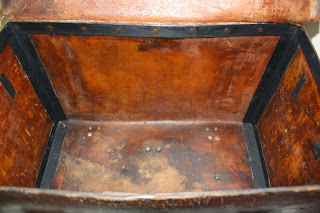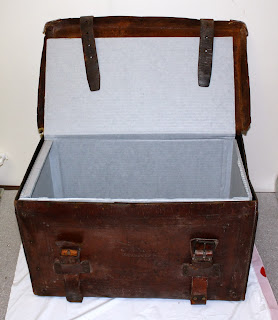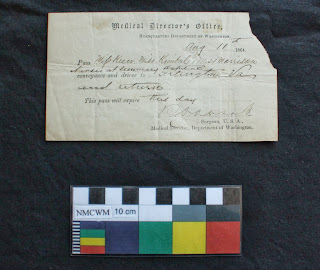Most museums, mine included, have far more artifacts than
they can display all at once. So, the artifacts
which are not in display are kept in the museum’s collection room. Here they are stored in fairly stable
environment conditions, which help to preserve them. However, even under ideal conditions there
can still be issues which arise. This is
why I routinely monitor the artifacts there.
So, when I recently discovered some whitish spots all over a large
leather medical trunk, I was not at all pleased!
 |
| This leather trunk, or pannier, was used to transport medicines and medical supplies in the Civil War. You can see the areas of white haze on the exterior. |
 |
| Things looked even worse when I checked the interior. It looked a lot like mold! |
I took the
pannier from the collection room to my conservation work room, partly in
preparation for removing the mold, but also to protect the rest of the
artifacts in the collection room from the mold.
Knowing that mold spores are airborne and had probably already spread
through the collection room was not a pleasant thought for me though! However, after doing some research I discovered
that it was not mold after all, but was actually “fatty spew” or “fatty
bloom.”
Fatty spew occurs
when the fats and oils in the leather migrate to the surface. Spew can be caused by issues during the
tanning process of the leather, or from the application of leather products
which contain oil or grease, or from environmental conditions, especially a
drop in the temperature. So, next I
researched ways of getting rid of the spots.
I found a number of suggestions, but ultimately decided to try the
gentlest and least-invasive method first – wiping the surface with a clean, damp
sponge.
 |
| The interior looks much better now! |
I understand from
my research that the fatty spew can possibly return. So, I will be keeping a closer watch on this
pannier. If that happens I can try some
different things, but I will first see if this simple fix does the trick.
 |
| Back on the shelf in the collection room, where it belongs! |
To see three
different medical panniers from the Civil War, click here.
Photos courtesy of the National Museum of Civil War Medicine.
















